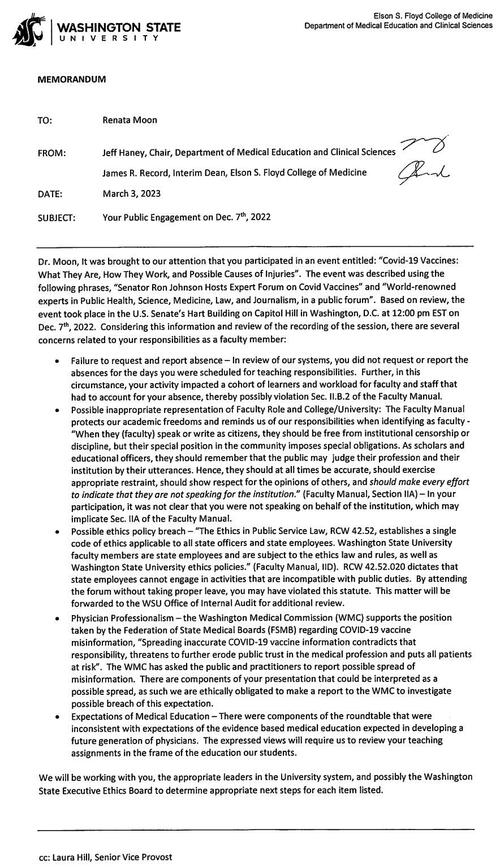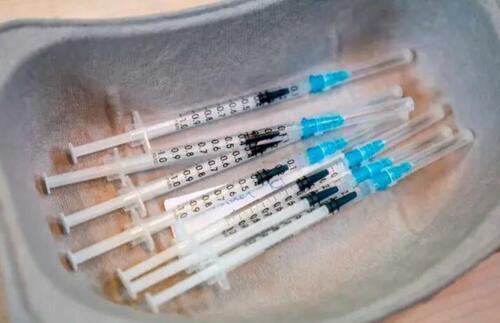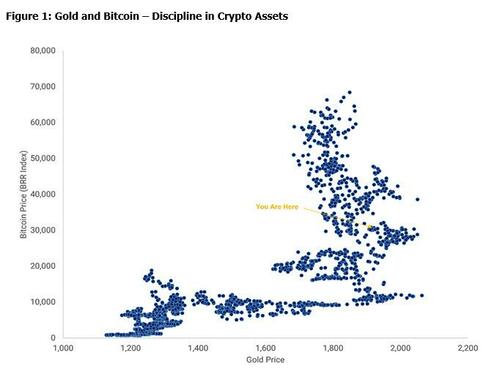Authored by Zachary Stieber and Jan Jekielek via The Epoch Times,
A medical expert was terminated by one of her employers after raising concerns about the safety of COVID-19 vaccines during an event held by a U.S. senator, according to newly disclosed documents.

Dr. Renata Moon, a pediatrician, poses for a picture in Washington on July 28, 2023. (Madalina Vasiliu/The Epoch Times)
After Dr. Renata Moon (who will appear on “American Thought Leaders” premiering Mon. Aug. 30, 7:30pm ET) testified during the December 2022 event on Capitol Hill, Washington State University officials told her that they were alerting a state medical commission because she allegedly promoted misinformation, one of the documents shows.
The Washington Medical Commission (WMC) has said that doctors who offer misinformation about COVID-19 vaccines, treatments, and preventative measures “erode the public trust in the medical profession and endanger patients,” that people should lodge complaints against doctors who allegedly provide misinformation, and that it may revoke the licenses of doctors who are found to have spread misinformation.
Drs. Jeff Haney and James Record, Washington State University officials, referenced the commission in a letter to Dr. Moon dated March 3, 2023.
“The WMC has asked the public and practitioners to report possible spread of misinformation. There are components of your presentation that could be interpreted as a possible spread,” they wrote. “As such, we are ethically obligated to make a report to the WMC to investigate possible breach of this expectation.”
The university informed Dr. Moon in June 2023 that it was effectively firing her by not renewing her appointment as a clinical associate professor of medicine, according to other documents reviewed by The Epoch Times.
“At this time, the needs of the college are moving in a different direction and your participation is no longer required,” Drs. Haney and Record wrote.
More detailed reasoning was not provided.
“This is not about my personal situation with the school. This is about freedom of speech for all Americans,” Dr. Moon told The Epoch Times in an email.
“We must create an ethical healthcare system that is concerned only with the well being of individual patients and not the financial interests of massive corporations. We are dealing with conflicts of interest that are larger than any of us ever imagined.”
Testimony
Sen. Ron Johnson (R-Wis.) convened Dr. Moon and other experts, including Drs. Peter McCullough and Robert Malone, to talk about COVID-19 vaccines. The event was titled, “COVID-19 Vaccines: What They Are, How They Work, and Possible Causes of Injuries.”
Dr. Moon testified that she had only seen two or three cases of myocarditis, a form of heart inflammation, while practicing for more than 20 years. But after the COVID-19 vaccines were rolled out, she said, she has been seeing more cases, and heard about others from fellow doctors.
“There’s clearly been a massive increase,” Dr. Moon said.
Dr. Moon also pulled out the package insert for the vaccines, or a piece of paper that typically outlines warnings, ingredients, and other information for a vaccine. The insert for the COVID-19 vaccines has no information and says, “intentionally blank,” the U.S. Food and Drug Administration has acknowledged.
“How am I to give informed consent to parents when this is what I have?” Dr. Moon said.
Regulators say people can access the information that is usually on the paper on the administration’s website. One of the vaccine manufacturers has said that the COVID-19 vaccine inserts were left blank because the information was being updated during the COVID-19 pandemic.
“I have a government telling me that I have to say ‘safe and effective’ and if I don’t, my license is at threat. We’re seeing an uptick in myocarditis. We’re seeing an uptick in adverse reactions. We have trusted these regulatory agencies—I have—for my entire career up until now,” Dr. Moon testified.
“Something is extremely wrong, and that is the anecdotal story that I have.”
Myocarditis is caused by the COVID-19 vaccines, U.S. officials have confirmed. The heart inflammation primarily affects younger males and can cause death.
“It’s my obligation to speak out. It’s the obligation of any physician who thinks that there is a problem with a product to speak about that product, whether, honestly, whether they’re right or wrong,” Dr. Moon said on EpochTV’s “ATL: Now.”
“And in this case, everything I said was completely factual.”

Other Concerns
Drs. Haney and Record claimed Dr. Moon failed to request and report an absence in order to travel to Washington and testify on the panel, which would violate faculty rules.
They also said that Dr. Moon did not make clear she was not speaking on behalf of Washington State University, another possible rule violation, and that other parts of the roundtable were “inconsistent with expectations of the evidence-based medical education expected in developing a future generation of physicians.”
They added, “The expressed views will require us to review your teaching assignments in the frame of the education of our students.”
Emails reviewed by The Epoch Times show Dr. Moon did not list the university in a bio she provided Mr. Johnson’s office. The bio stated that her views were her own and that she was not speaking on behalf of any institutions with which she has or is affiliated.
Mr. Johnson, in introducing Dr. Moon, did not mention any institution but also did not mention the latter part of the bio.
Dr. Moon’s placard did not list an institution. One of the video streams of the panel listed Washington State University. A university investigator noted that in one email.
“I was unaware of this happening and did everything in my power to prevent it by sending the press release and making sure not to mention the name of any employer either with my words or on the cardboard placard in front of me,” Dr. Moon told The Epoch Times.
According to other emails, Dr. Moon requested substitutes for Dec. 6, 2021, and Dec. 8, 2021, the days before and after the panel. She was not scheduled to teach on the day of the panel. University employees responded to the messages by saying they were looking for or had found substitutes, and the university investigator confirmed that substitutes were ultimately found for both days.
“I did it the way we’ve always done it. My senior physicians approved it; we had substitutes for my classes,” Dr. Moon told The Epoch Times.
A university spokesman declined to comment on the situation.
“As a matter of policy WSU does not comment on personnel matters,” the spokesman told The Epoch Times via email.
It’s unclear if the university ultimately referred Dr. Moon to the medical commission. Dr. Moon is part of a lawsuit against the commission for enforcing its misinformation statement without proper adoption. She says the threat of having her license revoked caused her to not renew her license and has impacted her constitutional right to free speech.
Trend?
Dr. Moon said she’s concerned about medical schools no longer serving as venues for discussion and critical thinking.
She recalled being called into the office of a superior over student complaints. She learned that the students complained about Dr. Moon noting correctly that some information about the COVID-19 vaccines was unknown, such as where in the body the ingredients were distributed and whether they would cause certain health problems.
“I just engaged in some critical thinking with my students. I thought it was something that we’re supposed to do in discussion groups, and they had asked me, right?” Dr. Moon said.
“They said that I had caused them trauma and harm by telling them that the vaccines might not be 100 percent safe. Again, these are medical students. This is a medical school. Nothing is 100 percent safe, not even aspirin is 100 percent safe. Everything has the potential for a reaction. So to have that be a complaint against me really surprised me and it really concerned me.”
Another complaint related to how Dr. Moon, after students asked how her week in the clinic had gone, relayed how she had seen anxious and depressed children.
Dr. Moon attributed the problems to the harsh lockdowns imposed in Washington state, like much of the country, and questioned why those policies were put into place when children face little risk from COVID-19.
“I just said to my students, I think we need to rethink this masking that we’re doing and the social distancing and isolating, I wonder if CDC has considered that we need to think about isolating our more vulnerable in our communities and keeping them more safe and keeping them at home but letting our kids go out there,” Dr. Moon said, referring to the U.S. Centers for Disease Control and Prevention.
“My students again stated that they were traumatized and harmed by that discussion, in a discussion group in a graduate-level medical school,” Dr. Moon said. “This is happening nationwide. Our students have lost that ability, I think, to tolerate critical thinking, and to hear perspectives that are different than the main narrative or the main party line that is being pushed.”
















